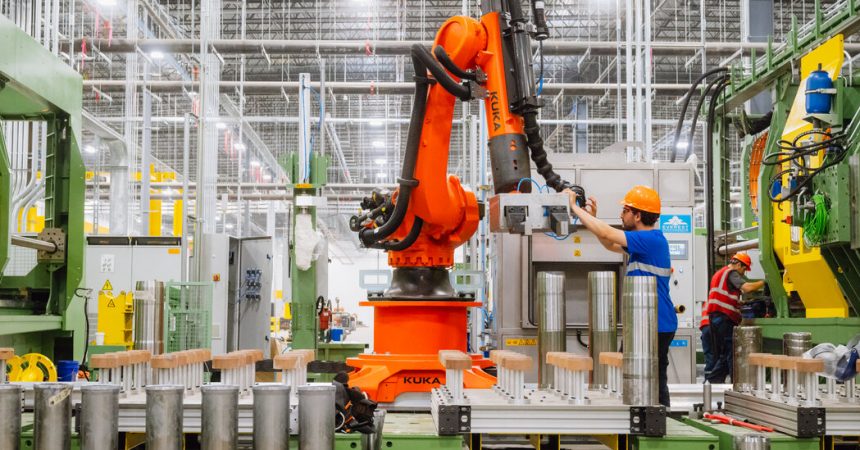In a warehouse off Lyndon B. Johnson Freeway in an industrial area outside Dallas, the future of American military ammunition production is coming online.
Here, in the Pentagon’s first new major arms plant built since Russia invaded Ukraine, Turkish workers in orange hard hats are busy unpacking wood crates stenciled with the name Repkon, a defense company based in Istanbul, and assembling computer-controlled robots and lathes.
The factory will soon turn out about 30,000 steel shells every month for the 155-millimeter howitzers that have become crucial to Kyiv’s war effort.
Ukraine fired between 4,000 and 7,000 such shells daily for several months in 2023, according to NATO’s secretary-general, before infighting among House Republicans held up further funding for Pentagon arms shipments. Large shipments of American artillery ammunition resumed in April after Congress passed an aid package that included $61 billion to Ukraine.
The gap led to a drastic ammunition shortage for Kyiv, with Ukrainian troops able to fire only a fraction of the shells shot at them by Russian forces.
To keep Ukraine’s artillery crews supplied, the Pentagon set a production target last year of 100,000 shells per month by the end of 2025. Factories in Scranton and Wilkes-Barre, Pa., together make about 36,000 shells per month. The new General Dynamics facility in Mesquite, Texas, will make 30,000 each month once it reaches its full capacity.
The 100,000-per-month goal represents a nearly tenfold increase in production from a few years ago.
An Ohio-based defense firm called IMT is expected to make up the difference.
Less than a year ago, the surrounding area here in North Texas was just a dirt field. But with millions of dollars from Congress and help from Repkon, the American defense firm General Dynamics was able to open the factory about 10 months after breaking ground.
“Despite all our starts and stops with the government, the continuing resolutions and getting the last supplemental, the industrial base responds when you fund it and it’s done right,” William A. LaPlante, the Pentagon’s top acquisition official, said in an interview with his Army counterpart, Douglas R. Bush.
According to Mr. LaPlante, the United States has provided more than three million 155-millimeter shells to Kyiv since the war began in February 2022.
“When government and industry work together and Congress gives us sufficient latitude, we can still do great things in this country really fast,” Mr. Bush added.
Whether the increase in artillery ammunition production alone will be enough to change outcomes on the battlefield in Ukraine’s favor is, however, unknown.
“The steady increase of artillery ammunition production is significant for long-term U.S. and Ukrainian needs,” said Michael Kofman, an expert on the Russian military and a senior fellow at the Carnegie Endowment for International Peace, “but even in the best case scenario, I would say those late-2025 output targets will arrive late in this war, and it is likely that Russian artillery output will still be higher than the U.S. and Europe combined at that point.”
“Let’s say a year and a half from now both the U.S. and Europe are making, or buying, over a million shells each,” he added. “That’s still probably less than Russia is going to produce this year.”
The Mesquite factory will consist of three production lines in different buildings — one of which will share space with a distribution center for Frito-Lay that had a Cheetos-branded truck parked outside. When all three lines are completed, most of the Turkish workers will go home.
Half of the on-site American work force came from another General Dynamics plant about 10 miles north in Garland, where the company forges steel casings for aerial bombs. The Mesquite factory will add about 350 jobs to the local economy when it reaches its full production capacity next year, company officials said.
It can take days to forge shells at the military’s current factories in Pennsylvania, which use a combination of new and nearly century-old technologies to heat and press steel billets into tapered projectiles. But the new plant in Mesquite spins rounds out much faster.
The shorter turnaround comes from the use of something called flow forming — a machine inside an enclosure roughly the size of a city bus rotates a 130-pound steel cup at high speed while simultaneously squeezing it until it becomes a long gleaming cylinder. From there, robots do much of the remaining work.
A series of identical orange-colored robot arms throughout the factory grab the metal projectile parts from one machine and place them on small automated carts that drive them to the next station, where another robot gripper that slides along a track begins the next stage of the process.
Each robot’s work area is fenced in, and its openings are flanked by an “air gate” — a strip of sensors that allow Roomba-like carts to enter but shut machines down if they detect a human.
Humans are needed in a few steps to lift things along the way, often with a large yellow device bolted to the floor called a manipulator that allows them to move shells to other machines.
Laser scanners have replaced human eyes and hand tools for inspecting shells inside and out, quickly verifying that the projectiles are within their desired specifications.
Once complete, the empty shells made in Mesquite will be shipped to the Army’s sole facility for filling them with explosives — a World War II-era plant in Burlington, Iowa. Next year, however, many of the shells will be sent to another new General Dynamics factory that is under construction in Camden, Ark.
The Pentagon’s drive to reinvest in ammunition production will also result in the Army’s Iowa plant opening a second line for filling shells with explosives, and the partial reopening of a plant in Parsons, Kan., for packing artillery propellant charges that was largely shuttered in a round of base closures in the 2000s.
Once complete, an unguided shell will be just under three feet long and weigh roughly 100 pounds — 24 pounds of which will be its explosive fill. That is enough to kill people within 150 feet of impact and cause injuries more than 400 feet away.
Mr. LaPlante and Mr. Bush both indicated that European countries were also ramping up their artillery ammunition production, and U.S. defense contractors are in talks with the Ukrainian government to find ways to help Ukraine bolster its own domestic defense industry.
The United States has transferred sensitive manufacturing plans for more than 1,000 American weapons to Kyiv, and translated an equal number of technical manuals from English to Ukrainian, the two officials said.
When asked, they stopped short of saying which weapons.
“What are they using the most?” Mr. Bush replied.






